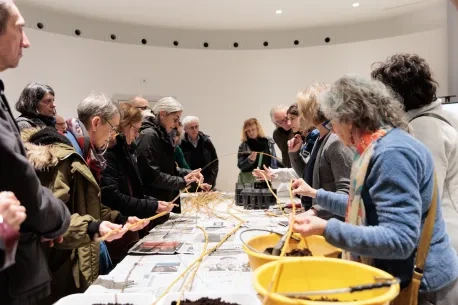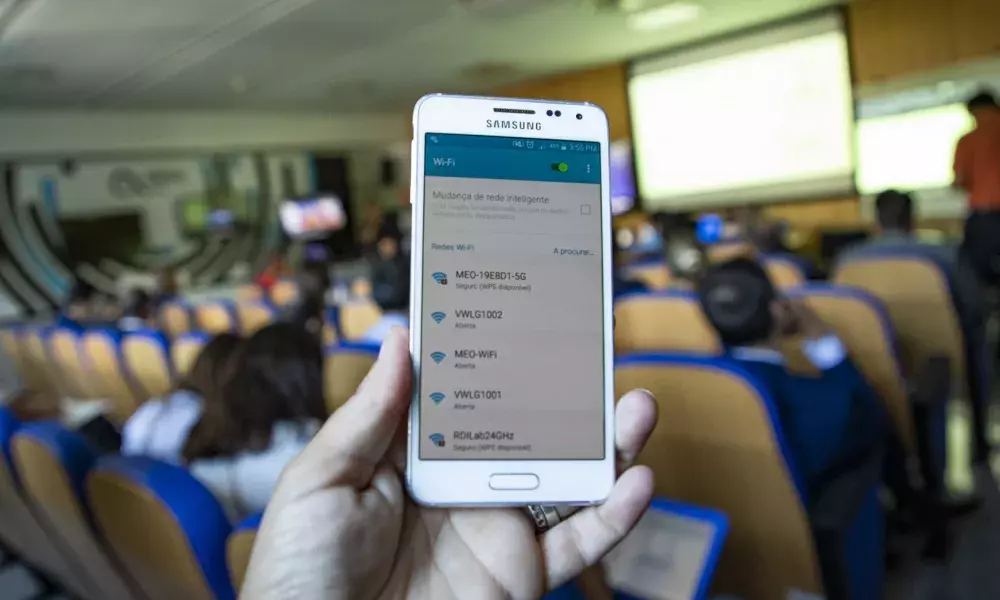
The city is also developing use cases that are supported by the living lab infrastructure, in 3 main areas: mobility, environment and energy.
Aveiro's Living Lab main objectives
- To potentiate the implementation of scientific research projects and the development of commercial technological solutions in the urban environment, especially the testing and development of new digital tools, through the provision of an advanced communications infrastructure and an urban platform with data analytic capability which together constitute the open digital laboratory at city scale;
- To attract and retain talents, namely innovative technology-based organisations, researchers, digital industries, entrepreneurs and other national and international stakeholders to the city of Aveiro, promoting it as one of Europe's pioneering cities for testing and experimenting with 5G and IoT-based digital products and services;
- To enhance the transition of the city of Aveiro to a knowledge-based economy, with the ultimate goal of improving the quality of life of its citizens.
The Living Lab infrastructure aims to be an authentic space for testing innovative solutions, where multiple stakeholders collaborate in the development, validation and testing of novel technologies and services in a real context.
Aveiro’s Living Lab is composed of an advanced communications infrastructure and an innovative urban platform that, together, allow the provision of an open and large-scale technological laboratory in the city at the service of researchers, digital industries, startups, scaleups, R&D centres, entrepreneurs and other stakeholders interested in developing, testing or demonstrating concepts, products or services.
Use cases are supported by the living lab infrastructure:
- The use case of mobility aims to understand citizens’ behaviours within the city, to provide new solutions towards an efficient traffic management.
- The use case of environment will focus on the assessment of the impact of the transport planning on the city air quality, thus providing useful information towards new environmental-friendly solutions.
- The energy use case will provide new solutions regarding the use of electrical vehicles (traditional gondolas called “moliceiros”) in the water canals.
The access infrastructure is based on the latest generation fibre technology, reconfigurable radio units, 5G network services and sensors for data collection, covering the urban area of Aveiro. All data gathered by use cases will convey into a new urban digital platform.
In a 2015 post published on Techcrunch, a very famous US blog that deals with information technology, the authors draw a strange parallelism: they point out that the companies that have grown fastest in the last 10 years are companies that perform as platforms; therefore they ask the readers: can this trend also be borrowed for cities? Can cities be technologically disrupted?
According to the authors the answer is definitely yes: cities, to evolve, must be viewed as platforms, with population encouraged to utilize technology to creatively disrupt and redefine core functionalities. Every digitally enabled citizen living in a city is a hub of real-time data: let’s think of the city as possessing its own complex but penetrable API!They invite the readers to recognize that, like its physical architecture, city’s digital foundations can be augmented and sustainable solutions can be built from the data we collectively produce.
The “concept” of the living labs partially integrates this vision and enriches it with additional components. According to European Network of Living Labs (ENoLL) which is the international federation of benchmarked Living Labs in Europe and worldwide, a Living Lab is an “open innovation ecosystem based on a systematic user co-creation approach that integrates public and private research and innovation activities in communities, placing citizens at the centre of innovation.” By combining creative thinking with scientific rigour, living labs can be seen as open platforms, sourcing and prototyping ideas with people of different backgrounds, combining the expertise within the lab with the real world knowledge.
A couple of years ago the Guardian even declared the need, no longer to be deferred, for cities to become active as Living Labs, as places where designers, scientists, companies and customers collaborate to investigate, make and test ideas with the communities that live in them. Local people should be at the heart of development. The number and thematic areas of Living Labs have been steadily growing since the launch of ENoLL about ten years ago and currently there are 170 official recognised Living Labs across the world running projects.
The majority of Living Labs have tackled one of the following three goals:
- Mobility à enabling and improving mobility as a service, encouraging more non-motorized transport
- Environment and well-being à mitigating climate change impacts, reducing noise and air pollution
- Citizen engagement à increasing citizen engagement in decision making and increasing a greater level of diversity in political engagement.
Examples of domains, where solutions were tested and developed, include:
- High tech, hyper local, personalized wayfinding based on crowding and traffic data
- Autonomous delivery
- Interactive apps
- Waste collection
- Smart urban furniture.
Living Labs can be used for a diverse range of purposes and are not limited to the above, including designing user-friendly apartments, reducing food spoilage, creating smart cycling plans, reorganizing learning spaces to support new styles of teaching, reducing congestion on sidewalks, delivering better services to deaf and blind populations and discouraging radicalism among young people.
The city of Aveiro is committed to developing a technological urban centre of reference at European level, by promoting the development of innovative solutions, through the creation of the first Living Lab of the city, placed in the city centre.
The Aveiro Steam City’s Digital Urban Platform is the services’ enabler core of the City that collects, analyses and combines data from multiple sources to deliver real-time high added-value information for quick decision-making at strategic, tactical and operational levels. The platform services are offered in a virtualized, elastic and secure cloud environment, which makes it particularly suitable to be used by other cities or different activity sectors such as Smart Cities, Industry 4.0 or Mobility, just to mention a few. By relying on a “as a service” model, the platform services can be easily replicated, fostering the creation of agile and open digital services for citizens and the development of city’s innovation ecosystem.
The urban platform, currently under development, will allow the reception, treatment and analysis of data and the sharing of information from various sources (sensors, integrable databases, and others), providing analytical and predictive services for IoT applications and vertical applications for the city. Technical support will also be provided to Living Lab users, allowing them to take full advantage of the potential of the infrastructure, urban platform services and available data.
Besides the value arising from the individual exploitation of platform’s analytic capabilities, the additional value created by the digital urban platform directly depends on the number of entities that are willing to locate and share its data with the other public or private users of the platform. The more the data available in the platform the richer the information one can generate to support a business decision-making or investigating a new business process or technological solution. Experts from Altice Lab believe that attracting and involving new “operators” to this ecosystem will highly depend on the deployment of a well-established set of use cases that enlighten the advantages of the concept behind the platform and a clear and open strategy of information sharing, focused on the positive impact in the community – municipality, local industries and commerce, academia, city visitors and citizens.
The urban platform is composed of an integration, aggregation and processing component of data from various information sources, such as:
- Electrical energy consumption
- Statistics and performance of the experimental communications network
- Garbage collection
- Environmental sensors
- Vehicular units
- Mobility
- Municipal activity and performance according to ISO 37120 standard
- Gas and water consumption
The data integration component also has the ability to manage APIs, allowing the creation of APIs for dissemination of specific information datasets according to the needs of each project or experimental activity. The urban platform also includes a data visualization and exploration component, designated as a city governance centre. This component provides access to various sources of information, in tabular, graphic and geographic format, allowing an analysis and correlation of data. Access to this data access interface can be made available for experimental projects in the territory.
“The urban platform will improve City agents’ capacity in three main axes:
i) Local administration management
ii) Private businesses and investors’ building capacity
iii) Citizens information tools.
In one hand, the local authority will have access to several types of data verticals, such as, municipality’s finances and internal departments processes workflow, which will improve cross-departmental efficiency within municipality’s procedures and services delivery. On the other hand, environmental, energy, mobility and social-economic data will allow the city’s management to have a depth knowledge of the city, sustained by continuous updated indicators and information, which will ultimately support decision makers in various areas of the municipality. Another capability of the platform, which is related to the second axis, is the building capacity of investors and private companies by testing and creating solutions and innovative products using the data available in the platform. This opportunity will allow Aveiro to leverage its living lab, combining the urban data platform with the 5G and fibre infrastructure. Also, the data available on the platform, alongside with other policies of investment’s uptake, will allow investors to have a clear idea of city’s profile in terms of infrastructures, services, HR skills and other information to help them to establish their company in Aveiro. Finally, there is also a very important dimension to take into account which is providing information and data to local community, improving their access to real time information, helping citizens to take better informed decisions about their daily life in the city”
Within the scope of the European project Aveiro STEAM City, Instituto de Telecomunicações (IT) is building a Next Generation Communications Platform (Radio) Supported by Fiber Optics and an Open Wireless City Network, available for the development, testing and demonstration of concepts, products and services, thus becoming a large-scale technological laboratory located in the city of Aveiro.
The Open Wireless City Network is installed in the urban area of the city of Aveiro: around the city 43 radio access points are placed, 27 on smart lamp posts, and 16 on building facades. The radio components are not identical at all radio access points, with the presence of SDR-based 4G / 5G being limited to 24 points.

Living Lab technical characterization
The Aveiro Living Lab infrastructure also includes a set of equipment installed in the urban centre, which allows monitoring functions or interaction with the users.
As examples:
- Environmental sensors
- Mobility sensors
- Energy sensors
- Smart benches
- Bicycles smart lights (braking, road conditions, swerving, insights data)
- Interactive Muppies
- Bike-sharing system dock stations [to be installed in May 2021]
- Wi-Fi Antennas.
There is also vehicular sensors equipment installed in buses and garbage collection vehicles, which currently record the following data:
- Location and direction
- Speed
- Temperature
- Noise level
AVEIRO STEAM City 5G New Radio and network core deployment covers the most important city sites and roads. The aim of 5G network installation is to grant other project partners, stakeholders, projects and initiatives – e.g. Aveiro 5G Challenges – the access to high bandwidth, low latency and ultra-reliable communications that could foster innovation and value creation.
Aveiro STEAM City 5G Testbed also provides computational capacity for instantiation of virtual entities (VNF), in the form of Virtual Machines (VM), over OpenStack. These VMs can be available in a central or edge data centre (DC). Support to 5G Testbed usage and applications testing will be provided by specialized teams and covers – VPN access, computing resources utilization, terminals and SIM cards issues.
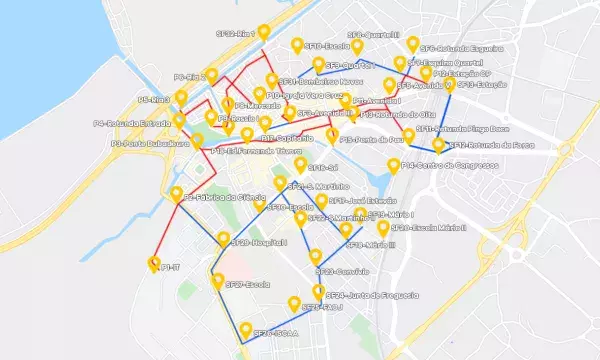
Network access points location
The geographic area with 5G connectivity comprises, in the first phase, the city centre, which includes Ria Central Channel, between Aveiro Congress Centre and General Humberto Delgado Square.
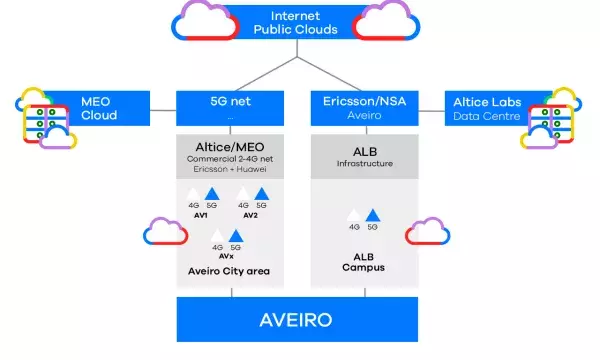
5G Testbed Network - deployment scenario
Altice Labs has set up a 5G laboratory in collaboration Ericsson, focused on experimentation, deploying and testing of 5G technologies and services, that goes behind a closed test environment – at Altice Lab campus – and extends to the commercial mobile 5G network operated by Altice/Meo, establishing a complete ecosystem – core network, edge functions and 5G-NR (New Radio) radio, using massive MIMO antennas in the 3.6GHz band, allowing to test new services and applications in a broader environment with “real” users.
The first stage of the testbed deployment was demonstrated last year (2019), on September 11th, when a car accident was simulated to demonstrate the relevance of 5G technology to support rescue teams - security, fire brigade and emergency medical teams – in a Public Protection and Disaster Recovery (PPDR) situation. This showcase has demonstrated how 5G increases the effectiveness in real situations, in this particular case the rescue, by allowing real-time high-quality images of the accident scene and vital signs transmission of the injured. Since then the network has been enlarged with three more base stations, located in the city centre and nearby the University Campus and also to the Fairs and Exhibitions Park in Aveiro, on the occasion of Techdays'2019.
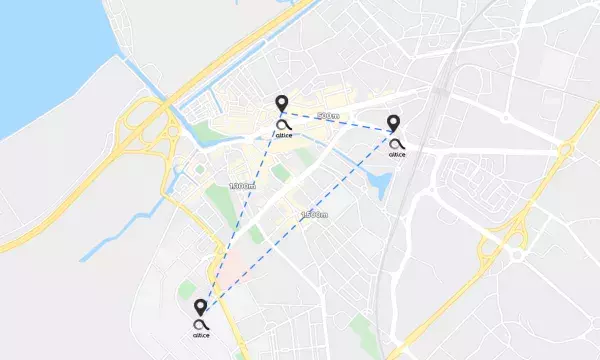
5G-NR antennas location in Aveiro
“Although one may say that 5G is still giving its first steps towards technical consolidation and adoption, it is becoming clearly every day that this is the technology that will set the stage for a wide range of application that longed to emerge. In the urban space, 5G cellular network emerges as a reliable, secure and fast way to provide a city-wide integration scenario for innovative V2X (Vehicle-to-Everything) services. The enhanced mobile broadband and extremely low latency brought by 5G will play an essential role in the city road infrastructure security management, namely by improving road-network assessment and risk mapping process and enabling the emergence of new applications and services for vulnerable road users (VRU) alerting or Vehicle-to-Infrastructure (V2I) communications. Moreover, we also expect that mobile 5G technology in the urban space will make an important contribution for the advent of quite a lot of enhanced augmented reality applications that besides providing useful information to a city tour – e.g. local commerce or historical information – may guide residents and non-residents in the complex business life of the city”
It’s interesting to make a few comparisons with some very significant European running living labs:
Copenhagen Street Lab (https://cphsolutionslab.dk/en/what-we-do/labs/street-lab) is a laboratory in the city centre where it’s possible to test new solutions under real urban conditions. The objective is to test the solutions for their potential and limitations, so to assess what can be scaled to larger areas of the city. Therefore, Street Lab is a vital source of knowledge about the solutions that work, thus making it possible be one step ahead of city operations and services for Copenhageners.
Since Copenhagen Municipality established the Street Lab test area in 2016, they have tested solutions in areas such as smart parking, care of urban nature, waste management and measurement of air quality. Street Lab was developed in a public-private partnership between Cisco, TDC, Citelum and Copenhagen Solutions Lab.
Copenhagen street lab is very interesting, not only because of the effectiveness of the experiment, but also because of the contractual framework they were able to set. The agreement with private operators is framed through a Public Private Innovation Partnership (art.14 public procurement Directive).
The PPI project is divided into 6 phases:
-
- Design of the basic smart city infrastructure
- Contruction of the basic smart city infrastructure
- Trial period
- Evaluation of infrastructure and use cases
- Operation and mainainance of the basic smart city infrastructure
- Develop, implement and test new use cases.
This contractual framework was very much appreciated by policy makers during the deployment of interventions because it let them be able to develop, evaluate and correct the quality of the process through a methodology similar to the “startup lean approach”, so by small adjustment, without binding them with long term contracts with a number of fixed private partners.
This can be of inspiration also for Aveiro’s policy makers, thinking in advance about the future of the experimentations, in case the Municipality would like to procure some of the most successful services that with arise from the Living Lab public call.
Another interesting model to consider as food for thoughts is the one developed in the city of Amsterdam.
Amsterdam has the greatest broadband connectivity and second- highest Internet connection density in the world. The first living lab was launched in 2015 and now the City has over 40 Living Labs https://www.ams-institute.org/how-we-work/living-labs/
Corporate partners include Cisco, IBM, JCDecaux, Intel and hundreds of experiments, tests, pilots are taking place throughout the urban space. The city provides open access to data to developers to test next generation interactive mobile applications that then also generate open data, creating new value chains across industries. The local government also provides funding and approvals for experiments throughout city; extra support is also provided by Amsterdam University of Applied Sciences.
The vision that inspires the civil servants is the one of an innovation playground where consumers, knowledge institutions, and companies work in close cooperation to develop new products and services and foundational to process is community engagement. The private sector plays an important role: large companies provide additional support (financial and in-kind) to smaller companies developing prototypes. This model can lead to further reflection for the case of Aveiro, once the Living lab will expand and – hopefully – scaled.
OPEN CALL TO LIVING LAB USERS
Aveiro Testbed is open to anyone who wish to test equipment, applications, technologies, products or services, develop R&D projects or access data made available by the urban platform, namely:
a) R&DI institutions (includes their researchers),
b) Individual entrepreneurs,
c) Start-ups, SMEs and Large Enterprises,
d) Universities (including their Academy),
e) others wishing to test innovative digital solutions or access data from the urban platform.
The Municipality is going to launch in the next months a public call in order to select the projects allowed to use the infrastructure for their innovative activities. Living lab’s users will be required to submit an application form, describing their project, objectives and required living lab’s assets (infrastructures, services and data). Projects will then be selected following a pre-established list of criteria such as degree of innovation, market potential and scalability, potential impact, skills of the candidates, work methodology and the degree of exploitation of the Living Lab assets (infrastructure and urban platform), meaning its potential for development and feasibility. During the pilot phase (until 31st December 2021) the use of the Living Lab is completely free of charge.
Why a private operator should be interested in submitting the application in order to become a living lab user?
Ana Mendes, from CEDES, states that “ The city of Aveiro has the ideal conditions for the development and testing of new technological solutions: on the one hand, it is small enough to carry out pilot tests of solutions in and controlled urban environment (about 80,000 citizens) and, on the other hand, it has the right infrastructure, technical support and co-work space to do so in its living lab. The exciting technological and innovative ecosystem provided in Aveiro comes from a prolific history in technology development, the establishment of recent tech-based business and the existence of a European top University, that all together are also drivers for the support and strive of new technical and innovative business solutions”.
To all Living Lab projects, the consortium will provide backup services and technical support, such as equipment installation and adaptation to the ecosystem, technical helpdesk for the fibre and sensor infrastructures, for the urban platform and for the 5G network.
About this resource
The Urban Innovative Actions (UIA) is a European Union initiative that provided funding to urban areas across Europe to test new and unproven solutions to urban challenges. The initiative had a total ERDF budget of €372 million for 2014-2020.
Similar content
